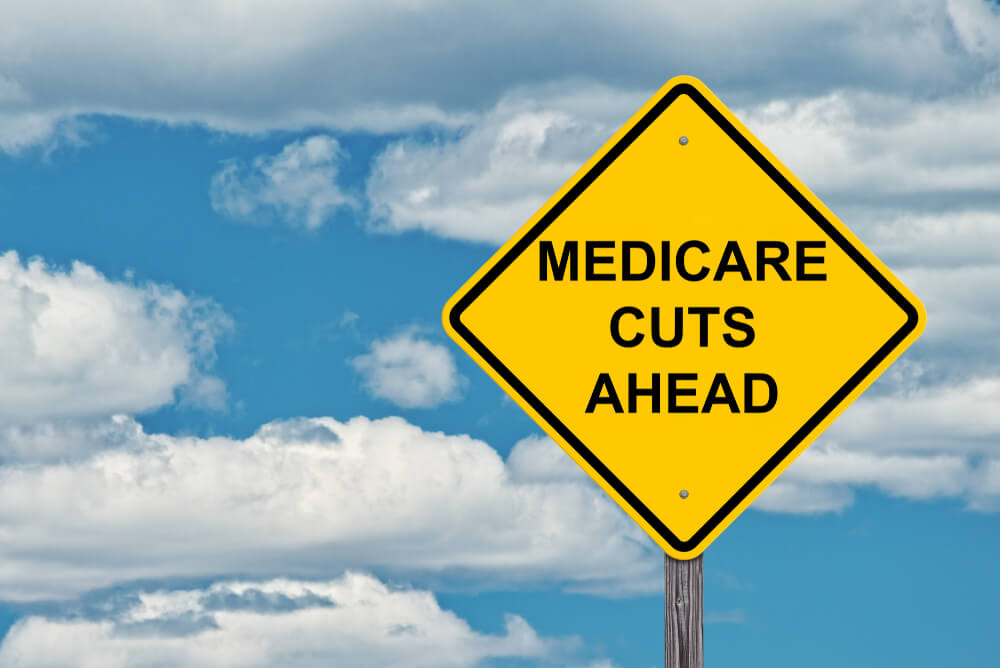The Trump administration unveiled its fiscal 2020 budget Monday, dramatically upping military and border security spending. But also in the budget are cuts to things candidate Donald Trump promised to protect while on the campaign trail, namely Medicare and Medicaid.
I was the first & only potential GOP candidate to state there will be no cuts to Social Security, Medicare & Medicaid. Huckabee copied me.
— Donald J. Trump (@realDonaldTrump) May 7, 2015
The Medicare cuts are $845 billion over the next decade.
The budget proposes a hard limit to what Medicare beneficiaries must pay for prescription drugs, an idea that has bipartisan support in Congress. The budget also includes a range of hospital cuts over the next decade, including reduced reimbursements for uncompensated care and lower rates for outpatient departments.
The budget itself doesn’t directly outline specific cuts to Medicare, but the devil is in the details. Instead, it sees spending reductions through prescription-drug legislation and efforts to reduce improper payments to health care providers.
“He’s not cutting Medicare in this budget,” Director of the Office of Management and Budget Russell Vought said at a press briefing Monday. “What we are doing is putting forward reforms that lower drug prices that, because Medicare pays a very large share of drug prices in this country, has the impact of finding savings. We are also fighting waste, fraud and abuse.”
Medicare will spend about $650 billion this year alone, and the administration says it is targeting wasteful spending.
Per the Washington Examiner:
Vought said that Medicare spending would still rise and that beneficiaries wouldn’t face any “structural” changes in their benefits.
The budget sees prescription drug reforms yielding $69 billion in savings, though some of the policies would require Congress to pass new laws. Ideas include banning high-cost brand name drugs from keeping generics off the market, negotiating the cost of drugs patients get at the hospital or in a doctor’s office, and approving generics faster. The budget also proposes to reduce what Medicare pays doctors and hospitals. Roughly $6.4 billion in savings would come from reducing fraud, waste and abuse. In all, Medicare spending would fall by 7.6 percent over a decade.
The cuts are part of a larger goal toward balancing the budget by 2034, which the budget achieves on paper by relying on rosy forecasts for economic growth. The budget projects 3.2 percent real gross domestic product growth for 2019, for instance, whereas the Federal Reserve and the Congressional Budget Office both expect 2.3 percent.
Democrats immediately went on the attack Monday, proclaiming the budget dead on arrival in the House of Representatives, where they have a strong majority.
While the cuts to Medicare won’t result in direct reductions in patient benefits, the proposals will no doubt be at the center of the Democrats’ attack during the 2020 presidential election and preceding debates, especially considering how successful they were in the House during midterm elections running largely on a health care platform.
Rep. Ted Lieu, D-Calif., tweeted several times that he is already mentioning the proposed cuts about “every fifteen minutes” to constituents.
I just concluded a live telephone town hall. Every fifteen minutes or so, I reminded constituents that @realDonaldTrump wants to cut $845 billion from Medicare.
If you or a loved one rely on Medicare, you vote for Trump at your peril in 2020. https://t.co/56FRW8aT3U
— Ted Lieu (@tedlieu) March 12, 2019
President Barack Obama also proposed cuts to Medicare through Obamacare, which cut $716 billion by slashing doctor and hospital payments, and by reducing spending on Medicare Advantage, a private health insurance option for Medicare. Former Obama speechwriter Jon Favreau also mentioned how Democrats will use the proposed cuts on the campaign trail in the build-up to 2020.
From a pure political perspective, this is – by far – the most radical, unpopular proposal that any 2020 candidate had put forward thus far.
Every Democrat should be talking about this every day. Start running the ads now and don’t stop until Election Day. https://t.co/OfHHQHQf2a
— Jon Favreau (@jonfavs) March 11, 2019
Two major hospital groups also have joined the fray, with Chip Kahn, president of the Federation of American Hospitals, calling the proposed cuts to Medicare “arbitrary and blunt,” adding that “the impact on care for seniors would be devastating.”
American Hospital Association President Rick Pollack said the cuts raise “serious concerns about how hospitals and health systems can ensure they serve as the safety net” for their patients.
For what it's worth, President Obama in his White House budgets proposed cutting Medicare by more than $400 billionhttps://t.co/nClPh9e3dA
— Jeff Stein (@JStein_WaPo) March 11, 2019
Trump’s 2020 budget plan also calls for a nationwide work requirement for low-income adults getting health insurance through the federal-state Medicaid program.
A national work requirement would reduce Medicaid spending by $130 billion over 10 years, according to the budget. Independent experts and advocates say that’s partly because it would leave millions uninsured.
Until now the Trump administration has given states the option of imposing their own work requirements. Some have done so, only to be taken to court.
The budget says “able-bodied, working-age” Medicaid recipients would have to find work, train for work or volunteer. It’s part of the administration’s drive to require work in anti-poverty programs, including food stamps.
The nonpartisan Kaiser Family Foundation estimates that 1.4 million to 4 million low-income people could lose Medicaid coverage.
Also per the Washington Examiner:
The healthcare industry, however, is no more pleased with proposals liberal Democrats have introduced on Medicare.
More than 100 House Democrats, including nearly every senator running for the Democratic presidential nomination, have proposed moving all people who live in the U.S. onto Medicare, while also having the program cover much more medical services than it does now. Such a move is projected to increase government spending on healthcare by about $32 trillion over a decade, according to the left-leaning Urban Institute and the right-leaning Mercatus Center at George Mason University.
The figure is $2 trillion less than current spending, but would come through cutting payments to healthcare providers by roughly 40 percent compared with what they get from private insurers. The latest version of the bill, unveiled in February, hasn’t yet been analyzed for cost.
In the president’s budget, the more significant cuts to government healthcare beneficiaries would be enacted through Medicaid, which covers low-income adults, people with disabilities, pregnant women, and children. The Trump administration opposes the way that Obamacare allowed low-income people to enroll in Medicaid regardless of disability status or whether they were working.
The budget requests rolling back Obamacare’s expansion of Medicaid and instead converting the program to a block grant in which states would get more say in how the money is spent. It also wants people on Medicaid to pay co-pays if they go to the emergency department for a non-emergency needs, and it would impose work requirements in exchange for coverage. The changes would reduce Medicaid spending by $241 billion.
“It’s clear that the administration is once again dead-set on cutting critical health care programs relied on by millions of Americans, especially ones impacting seniors and children,” Brad Woodhouse, executive director of the pro-Obamacare group Protect Our Care, said in a statement.
The Associated Press also contributed to this report.




